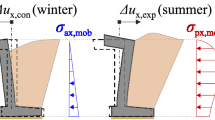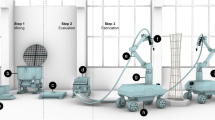Abstract
Geogrid reinforced pond ash is an effective composite material, which can be utilized as a construction material for various geotechnical engineering purposes. In this study, both experimental and numerical investigations have been carried out on shear strength characteristics of unreinforced and geogrid reinforced pond ash samples under undrained condition. Consolidated undrained (CU) triaxial tests have been performed on 100 mm x 200 mm cylindrical ash samples under static compressive loading. The investigations include the influence of confining pressure and number of geogrid layers on stress–strain characteristics of pond ash. Finite element package PLAXIS 2D was used for numerical simulation of unreinforced and geogrid reinforced pond ash models under undrained condition. Both experimental and numerical results show that the peak deviatoric stress increases as confining pressure increases for both unreinforced and reinforced ash samples. For a particular confining pressure, with increase in number of geogrid layers the value of peak deviatoric stress increases and its corresponding strain decreases. The increase in peak deviatoric stress is about 27%–93% for one-layer geogrid reinforced sample and 37%–117% for two-layer geogrid reinforced sample compared to unreinforced ash sample. Finite element analysis shows a good match in the stress–strain plot with the experimental result.














Similar content being viewed by others
Availability of data and material
Geogrid is purchased from TECHFAB INDIA.
Code availability
PLAXIS 2D software is used.
Abbreviations
- CU:
-
Consolidated undrained
- OMC:
-
Optimum moisture content
- R inter :
-
Material characteristics of the interface
- k :
-
Coefficient of permeability (m/sec)
- p :
-
Mean normal stress (kPa)
- p′:
-
Mean effective stress (kPa)
- q :
-
Deviatoric stress (kPa)
References
Parswal IS, Makan OP, Atrea AK (2003) Eco friendly ash management in the form of ash mounds. In: Proceedings of CBIP 3rd international conference-fly ash utilizations and disposal, New Delhi, India, pp 10–16
Huang HW (1990) The use of bottom ash in highway embankments, subgrade, and subbases. Joint highway research project, Final Report, FHWA/IN/JHRP-90/4, Purdue University, West Lafayette, Indiana
Datta M (1998) Engineering properties of coal ash. In: Proceedings of Indian geotechnical conference. Delhi, pp 41–46
Kumar S, Stewart J (2003) Evaluation of Illinois pulverized coal combustion dry bottom ash for use in geotechnical engineering applications. J Energy Eng 129(2):42–55
Kim B, Prezzi M, Salgado R (2005) Geotechnical properties of fly and bottom ash mixtures for use in highway embankments. J Geotech Geoenviron Eng ASCE 131(7):914–924
Sridharan A, Pandian NS, Rajasekhar C (1996) Geotechnical characterization of pond ash. Ash ponds and ash disposal systems, pp 97–110
Datta M, Singh A, Kaniraj R (1996) Spatial variation of ash characteristics in an ash pond. Ash pond and ash disposal systems. Narosa Publishers, Delhi, pp 111–119
Pandian NS, Sridharan A, Chittibabu G (2001) Shear strength of coal ashes for geotechnical applications. In: Proceedings of the Indian geotechnical conference. Indore, India, pp 466–469
Indraratna B, Nutalaya P, Koo KS, Kuganenthira N (1991) Engineering behaviour of a low carbon, pozzolanic fly ash and its potential as a construction fill. Can Geotech J 28(4):542–555
Singh SP, Panda AP (1996) Utilization of fly ash in geotechnical construction. In: Proceedings of the Indian geotechnical conference. Madras, India, pp 547–550
Yudhbir L, Honjo Y (1991) Application of geotechnical engineering to environmental control. In: Proceedings of the 9th Asian regional conference on soil mechanics and foundation engineering. Bangkok, pp 431–469
Jakka RS, Ramana GV, Datta M (2010) Shear strength characteristics of loose and compacted pond ash. Geotech Geol Eng 28(6):763–778
Gray DH, Ohashi H (1983) Mechanics of fiber reinforcement in sand. J Geotech Eng 109(3):335–353
Haeri SM, Noorzad R, Oskoorouchi AM (2000) Effect of geotextile reinforcement on the mechanical behavior of sand. Geotext Geomembr 18(6):385–402
Zhang MX, Javadi AA, Min X (2006) Triaxial tests of sand reinforced with 3D inclusions. Geotext Geomembr 24(4):201–209
Latha GM, Murthy VS (2007) Effects of reinforcement form on the behavior of geosynthetic reinforced sand. Geotext Geomembr 25(1):23–32
Bera AK, Ghosh A, Ghosh A (2009) Shear strength response of reinforced pond ash. Constr Build Mater 23(6):2386–2393
Koerner RM (2005) Designing with geosynthetics, 5th edn. Prentice Hall, Upper Saddle River, NJ
Chowdhury S, Patra NR (2019) Effect of strain rate on cyclic behavior of pond ash reinforced with geocell. International Congress and Exhibition SUCI Springer, Cairo, pp 9–21
Chowdhury S, Patra NR (2020) Undrained response of geocell confined pond ash samples under static and cyclic loading. Geosyn Int (accepted).
ASTM D6637 (2001) Standard test method for determining tensile properties of geo-grids by single or multi-rib tensile method. ASTM International, West Conshohocken, PA
IS: 2720 (Part III) (1980) Tests for soils for determination of specific gravity. Bureau of Indian Standards, New Delhi, India
IS: 2720 (Part IV) (1985) Tests for soils for grain size analysis. Bureau of Indian Standards, New Delhi, India
IS: 2720 (Part VII) (1980) Test for soils for determination of water content—dry density relation using light weight compaction. Bureau of Indian Standards, New Delhi, India
IS: 2720 (Part XV) (1986) Tests for soils for determination of consolidation properties. Bureau of Indian Standards, New Delhi, India
IS: 2720 (Part V) (1985) Tests for soils for determination of liquid and plastic limit. Bureau of Indian Standards, New Delhi, India
IS: 2720 (Part XVII) (1986) Tests for soils for laboratory determination of permeability. Bureau of Indian Standards, New Delhi, India
IS: 2720 (Part XII) (1981) Test for soils for determination of shear strength parameters of soil from consolidated undrained triaxial compression test with measurement of pore water pressure. Bureau of Indian Standards, New Delhi, India
Brinkgreve RBJ, Broere W, Waterman D (2006) PLAXIS User’s Manual, Version 8. Delft, Netherlands
Funding
None.
Author information
Authors and Affiliations
Corresponding author
Ethics declarations
Conflict of interest
The authors declare that they have no conflict of interest.
Additional information
Publisher's Note
Springer Nature remains neutral with regard to jurisdictional claims in published maps and institutional affiliations.
Rights and permissions
About this article
Cite this article
Chowdhury, S., Patra, N.R. Experimental and Numerical Investigation on Undrained Behavior of Geogrid Reinforced Pond Ash. Indian Geotech J 51, 1182–1194 (2021). https://doi.org/10.1007/s40098-021-00540-9
Received:
Accepted:
Published:
Issue Date:
DOI: https://doi.org/10.1007/s40098-021-00540-9




